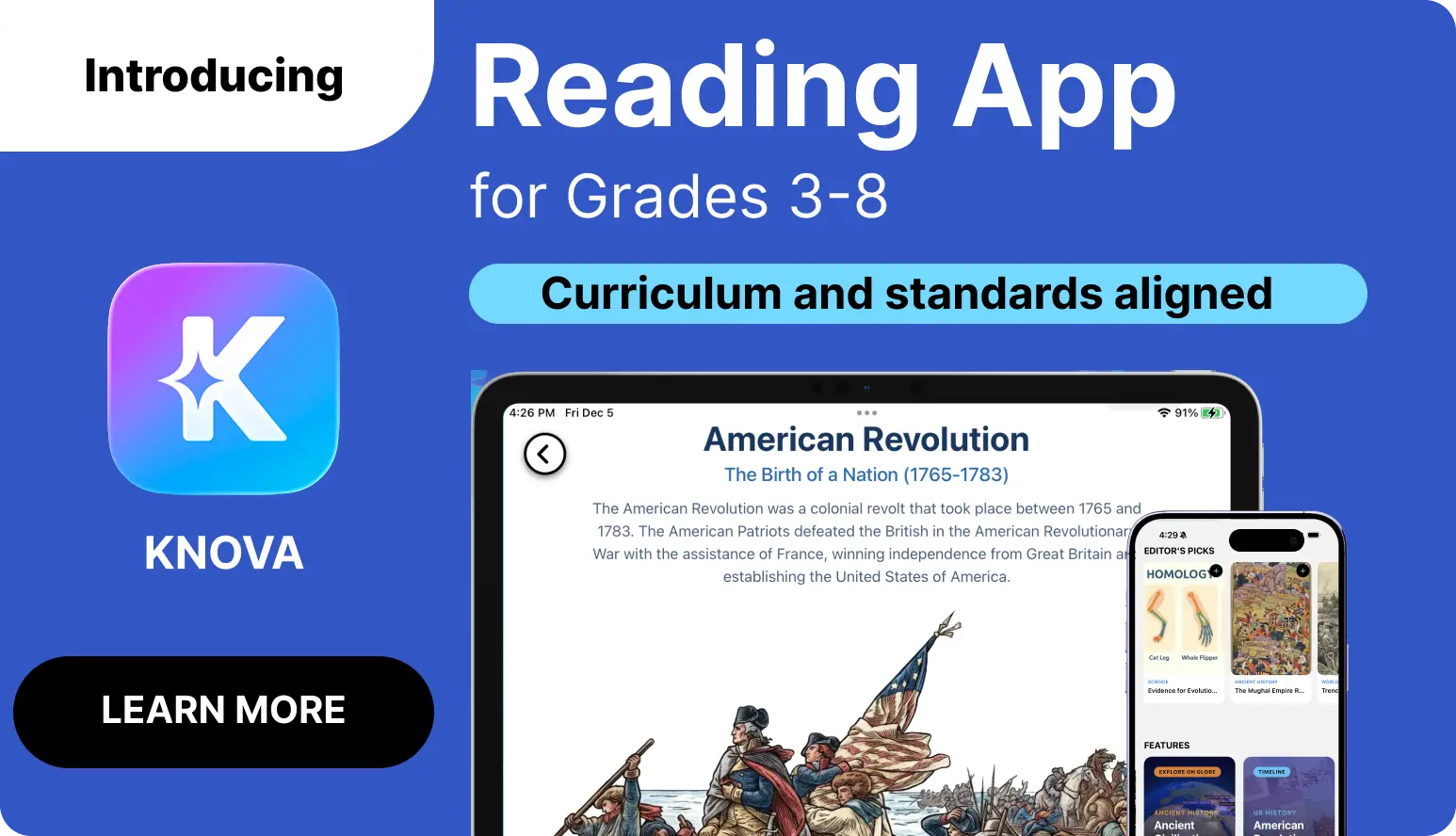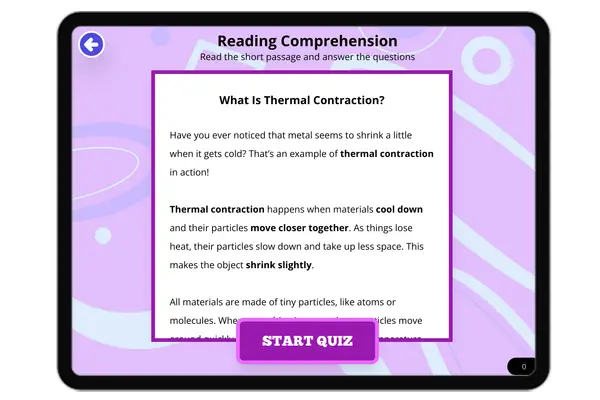Reading Results
How Things Move
This passage introduces kindergarteners to the basics of motion and forces, aligned with NGSS Standard K-PS2. Kids learn...
RL.1.1RL.2.2
Rolling and Sliding
This passage focuses on helping kindergarten students understand the differences between rolling and sliding, as outline...
K-PS2RL.1.1
Lily and Her Busy Day
This short story introduces young learners to the concepts of motion and forces, specifically rolling, sliding, and the ...
K-PS2RL.1.1
Observing Sunlight and Heat
This reading passage introduces children to the concept of how sunlight affects Earth’s surfaces. Using a relatable stor...
K-PS3-1RL.1.1
Warmth from the Sun
This reading passage tells the story of Liam at the beach, exploring how sunlight affects the temperature of rocks, sand...
K-PS3-1RL.1.1
Building Shade Structures
In this passage, Alex and Mia use a simple tent to block sunlight and create a cooler place to play. By observing the ef...
K-PS3-1RL.1.1
Shade from the Sun
In this story, Leo and Emma use an umbrella to block the sunlight and stay cool while playing in the park. By observing ...
K-PS3-1RL.1.1
The Marble Race
This passage addresses NGSS K-PS2-2 through a simple engineering investigation with marbles. Students learn how ramp ste...
K-K-PS2-2RL.1.1
Billy's Bouncing Ball
This passage supports NGSS K-PS2-2 learning by showing how design solutions can solve motion problems. Through trial and...
K-K-PS2-2RL.1.1
The Hot Slide
This passage explores NGSS K-PS3-1 through familiar playground experiences. Students observe how sunlight affects differ...
K-PS3-1RL.1.1
Beach Day Science
This passage addresses NGSS K-PS3-1 by comparing temperature differences in materials exposed to sunlight versus shade. ...
K-PS3-1RL.1.1
The Sun Shelter
This passage addresses NGSS K-PS3-2 through a practical experiment with sun shelters. Students learn how designed struct...
K-PS3-2RL.1.1
Maria's Cool Shade Idea
This passage supports NGSS K-PS3-2 learning by showing how simple structures can protect plants from sun damage. Through...
K-PS3-2RL.1.1
The Freezing Point of Water
This science reading passage, titled 'The Freezing Point of Water', introduces students to a key physical science concep...
MS-PS1-1RI.6.3RI.7.1
The Melting Point of Aluminum
This science reading passage, 'The Melting Point of Aluminum,' introduces middle school students to the physical propert...
5-PS1MS-PS1-4RI.6.3RI.7.1
Do Protons and Electrons Have the Same Mass?
This reading passage, 'Do Protons and Electrons Have the Same Mass?', helps middle school students explore the massive d...
MS-PS1HS-PS1RI.6.3RI.7.1
How Many Neutrons Does Hydrogen Have?
This reading passage, 'How Many Neutrons Does Hydrogen Have?', introduces middle school students to atomic structure usi...
MS-PS1HS-PS1RI.6.3RI.7.1
Understanding Specific Heat
This passage, 'Understanding Specific Heat,' explains the concept of specific heat to middle school students in an acces...
MS-PS3HS-PS3RI.6.3RI.7.1
Parts of an Atom
This reading passage on Parts of an Atom provides middle school students with a structured and accessible explanation of...
MS-PS1-1RI.6.3RI.7.1
Chemical Bonds
This reading passage on Chemical Bonds provides middle school students with a clear explanation of how and why atoms con...
MS-PS1-1RI.6.3RI.7.1
The Melting Point of Copper
This reading passage, 'The Melting Point of Copper,' introduces middle school students to an important physical property...
5-PS1MS-PS1-4RI.6.3RI.7.1
Freezing Point Depression
This passage, 'Freezing Point Depression,' introduces students to the physical science concept of how adding substances ...
5-PS1MS-PS1-4RI.6.3RI.7.1
The Specific Heat of Copper
This middle school reading passage, 'The Specific Heat of Copper,' explores how copper responds to heat due to its low s...
MS-PS3HS-PS3RI.6.3RI.7.1
Atomic Structure
This reading passage on Atomic Structure provides middle school students with an accessible explanation of the fundament...
MS-PS1-1RI.6.3RI.7.1
The Melting Point of Substances
This middle school science reading passage, titled 'The Melting Point of Substances', explores the physical property kno...
5-PS1MS-PS1-4RI.6.3RI.7.1
The Boiling Point of Water
This passage, 'The Boiling Point of Water,' introduces students to the physical property of boiling point through one of...
5-PS1MS-PS1-4RI.6.3RI.7.1
The Mass of a Proton
This reading passage, 'The Mass of a Proton,' introduces middle school students to one of the smallest yet most importan...
MS-PS1HS-PS1RI.6.3RI.7.1
What Charge Does a Neutron Have?
This middle school science passage, 'What Charge Does a Neutron Have?', teaches students about one of the key subatomic ...
MS-PS1HS-PS1RI.6.3RI.7.1
What Is the Charge of a Proton?
This reading passage, 'What Is the Charge of a Proton?', introduces middle school students to the concept of electric ch...
MS-PS1HS-PS1RI.6.3RI.7.1
The Melting Point of Steel
This engaging science passage, 'The Melting Point of Steel,' explains a key physical property of steel—its melting point...
5-PS1MS-PS1-4RI.6.3RI.7.1
The Specific Heat Capacity of Water
This middle school science reading passage, 'The Specific Heat Capacity of Water,' explains how water's high specific he...
MS-PS3HS-PS3RI.6.3RI.7.1
The Specific Heat of Ice
This middle school science passage, 'The Specific Heat of Ice,' explains how ice has a lower specific heat than liquid w...
MS-PS3HS-PS3RI.6.3RI.7.1
What Is Thermal Energy?
This middle school science passage, 'What Is Thermal Energy?', introduces students to the concept of energy from particl...
MS-PS3HS-PS3RI.6.3RI.7.1
What Is the Difference Between Thermal Energy and Heat?
This passage, 'What Is the Difference Between Thermal Energy and Heat?', helps middle school students understand the key...
MS-PS3HS-PS3RI.6.3RI.7.1
How Does Heat Move?
This engaging middle school science passage introduces students to the basic principles of heat transfer, aligning with ...
MS-PS3HS-PS3RI.6.3RI.7.1
What Is Conduction?
This middle school science passage explains the concept of conduction, focusing on how heat moves through solids. Aligne...
MS-PS3HS-PS3RI.6.3RI.7.1
What Is Conductivity?
This middle school science reading passage introduces students to the concept of conductivity, explaining how materials ...
MS-PS3HS-PS3RI.6.3RI.7.1
What Is an Example of Conduction?
This middle school science reading passage explains conduction through everyday examples, such as a hot metal spoon in s...
MS-PS3HS-PS3RI.6.3RI.7.1
What Is a Temperature Gradient?
This engaging science passage introduces students to the concept of a temperature gradient, a key idea aligned with the ...
MS-PS3HS-PS3RI.6.3RI.7.1
Heat Transfer Rate
This passage introduces students to the concept of heat transfer rate, aligned with NGSS standard MS-PS3-3. It explains ...
MS-PS3HS-PS3RI.6.3RI.7.1
What Is Entropy in Energy?
This passage introduces the concept of entropy in the context of energy, aligning with NGSS standard MS-PS3-4. It explai...
MS-PS3HS-PS3RI.6.3RI.7.1
What Is an Endothermic Reaction?
This engaging science passage introduces middle school readers to the concept of endothermic reactions, aligned with NGS...
MS-PS3-44-PS3-34-PS3-2
What Is an Exothermic Reaction?
This science passage introduces students to the idea of exothermic reactions—chemical changes that release heat or light...
MS-PS3-44-PS3-34-PS3-2
Is Freezing Endothermic or Exothermic?
This clear and accessible passage helps students understand why freezing is an exothermic process, even though frozen ob...
MS-PS3-44-PS3-34-PS3-2
What Is Thermal Contraction?
This middle school science passage introduces the concept of thermal contraction, aligned with NGSS standard MS-PS1-4. I...
MS-PS3-44-PS3-34-PS3-2
What Is Gravitational Energy?
This engaging science passage for middle school students explores the concept of gravitational energy, a form of potenti...
MS-PS3-44-PS3-34-PS3-2
What Is Kinetic Energy?
This NGSS-aligned reading passage introduces 6th–8th grade students to the concept of kinetic energy—energy that an obje...
MS-PS3-44-PS3-34-PS3-2
Understanding Mechanical Energy
This science passage is crafted for 6th–8th grade students and focuses on mechanical energy—specifically the combination...
MS-PS3-44-PS3-34-PS3-2
Chemical Energy
This informational science passage on chemical energy is designed for middle school students and aligns with the NGSS st...
MS-PS3-44-PS3-34-PS3-2





















































